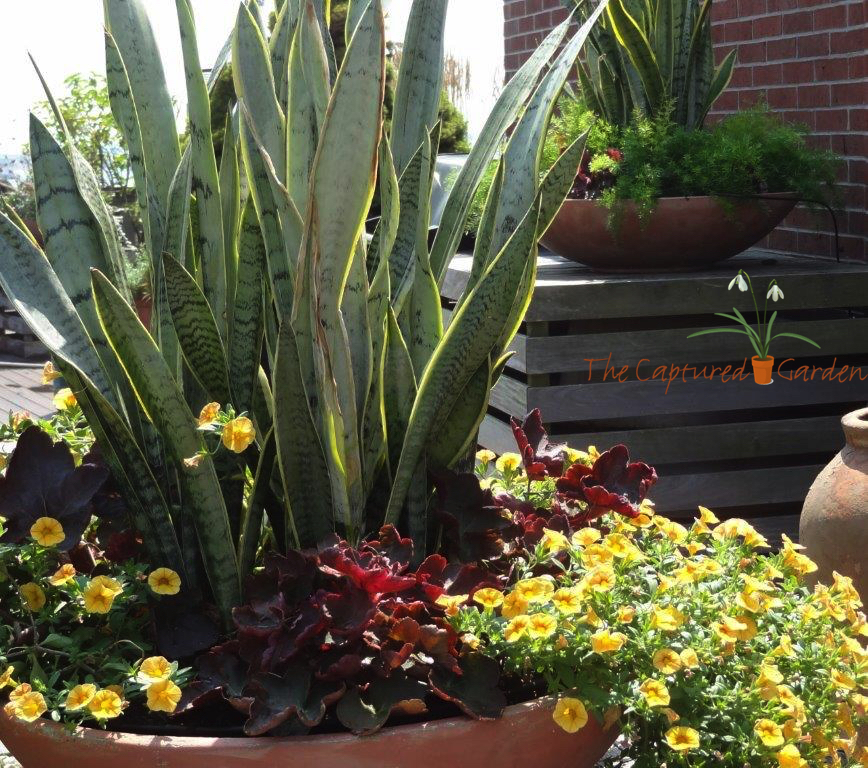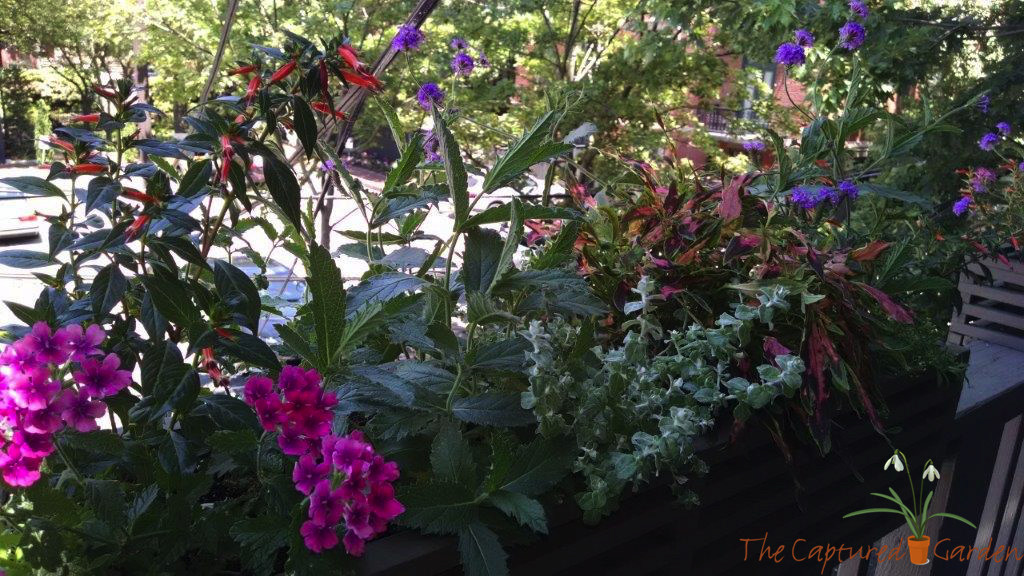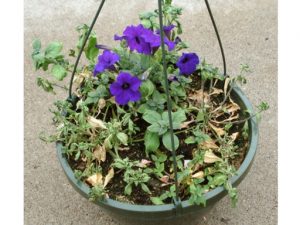Sayonara, Summer
As Fall approaches, we take a final look at some of our favorite summer projects.

Houseplant (sansevieria), perennial (heuchera) and million bells. Who says only annuals can go in containers? This mixed container is looking good 7 stories up!

This riot of colors on a South End balcony gets tied together with coleus ‘The Flume’.
Read More»Plant Lust
I was fortunate to accompany my friend, Kerry Mendez, on a recent garden tour where we were both stopped in our tracks by the most beautiful shrub. As we fumbled for our phones to takes pictures we asked the homeowner its name. Clerondendrum, or Harlequin Glorybower.

The name felt vaguely familiar but I could not recall it from the catalogs I routinely poured through. Apparently, it is hard to come by; which made me want it even more.
I did some research to find out if this beauty would do well in my garden.
Clerondendrum needs full sun (yes!) and grows between 10-15 feet tall and wide (no problem). It is covered with fragrant jasmine-like flowers in late summer (great!) which are followed by bright blue berries accented by pinkish-red calyxes (even better). When bruised, the leaves are thought to smell like peanut butter (I like peanut butter) which explains clerodendrum’s other common name, Peanut Butter Tree.
Clerodendrum can be marginally hardy in zone 6 (I will site it near a wall) but if it suffers dieback it will most likely rebound in spring.
It looks like I need to go on the great plant hunt to find a clerondendrum. If you spot one, please let me know.
Landscape Overhaul
Sometimes it’s time for a fresh start. And for this project, we knew it was that time. Our client, a member of the local garden club, was frustrated with the old, tired overgrown plants that were not contributing to the landscape and wanted to completely renovate her gardens. The area around the home had become overgrown, threatening to obscure its classic Royal Barry Willis lines.

So where did we start?
While some designers might favor a “blank slate” approach I prefer not to destroy material that is viable. Maybe it’s my frugal Yankee nature. If a plant doesn’t work where it is we can often move it and give it a second chance. After a thorough plant assessment, decisions are made as to what stays and what goes. When it comes to the “what goes” part all I can say is THANK GOD FOR A GREAT CREW.
Read More»Petunias Stopped Blooming? It’s Not You, It’s Them.
I recently received this email from a client with a roof garden in Boston:
“Just got home . Garden is beautiful!! Thank you.
In contrast, our Cape containers look terrible. They (mostly petunias ) were pretty good all summer. Then all of a sudden they stopped blooming. I had been using a fertilizer in solution weekly. The product is supposed to stimulate blooms. I did it weekly for about a month—the last time I doubled the dosage.
Do you think that I over-fertilized? Any thoughts? Can you do magic on Cape Cod?”
While I am more than happy to do magic on Cape Cod I, unfortunately, cannot do magic with petunias. I have never succeeded with them long-term. Perhaps I am doing something wrong but it’s one reason petunias made my lecture “The 10 Most-Popular Container Plants – And Why You Shouldn’t Use Them.”
 Petunias peter out, let’s be honest. They look gang-busters when you buy them in May and I think that’s why so many of us are seduced by their vibrant, brightly-colored little faces. We don’t look down the summer months and see that those same faces will resemble Grandma Moses. You can whack petunias back in July and hope that your hard-pruning will put the fear of God into them so they will bloom for your anticipated graduation/christening/bridal shower/first communion get-together. But that doesn’t always work. As I get older I get less sentimental. I am not interested in a plant that requires constant deadheading to look its best.
Petunias peter out, let’s be honest. They look gang-busters when you buy them in May and I think that’s why so many of us are seduced by their vibrant, brightly-colored little faces. We don’t look down the summer months and see that those same faces will resemble Grandma Moses. You can whack petunias back in July and hope that your hard-pruning will put the fear of God into them so they will bloom for your anticipated graduation/christening/bridal shower/first communion get-together. But that doesn’t always work. As I get older I get less sentimental. I am not interested in a plant that requires constant deadheading to look its best.
As my friend Kerry Mendez says “plants are not children or pets” we can get rid of them without guilt.
Which is what I do with petunias.
Out they go and are easily replaced with another colorful annual that will look even BETTER in August than it does in June. Are you wondering what that annual is?
Read More»

Follow Us!